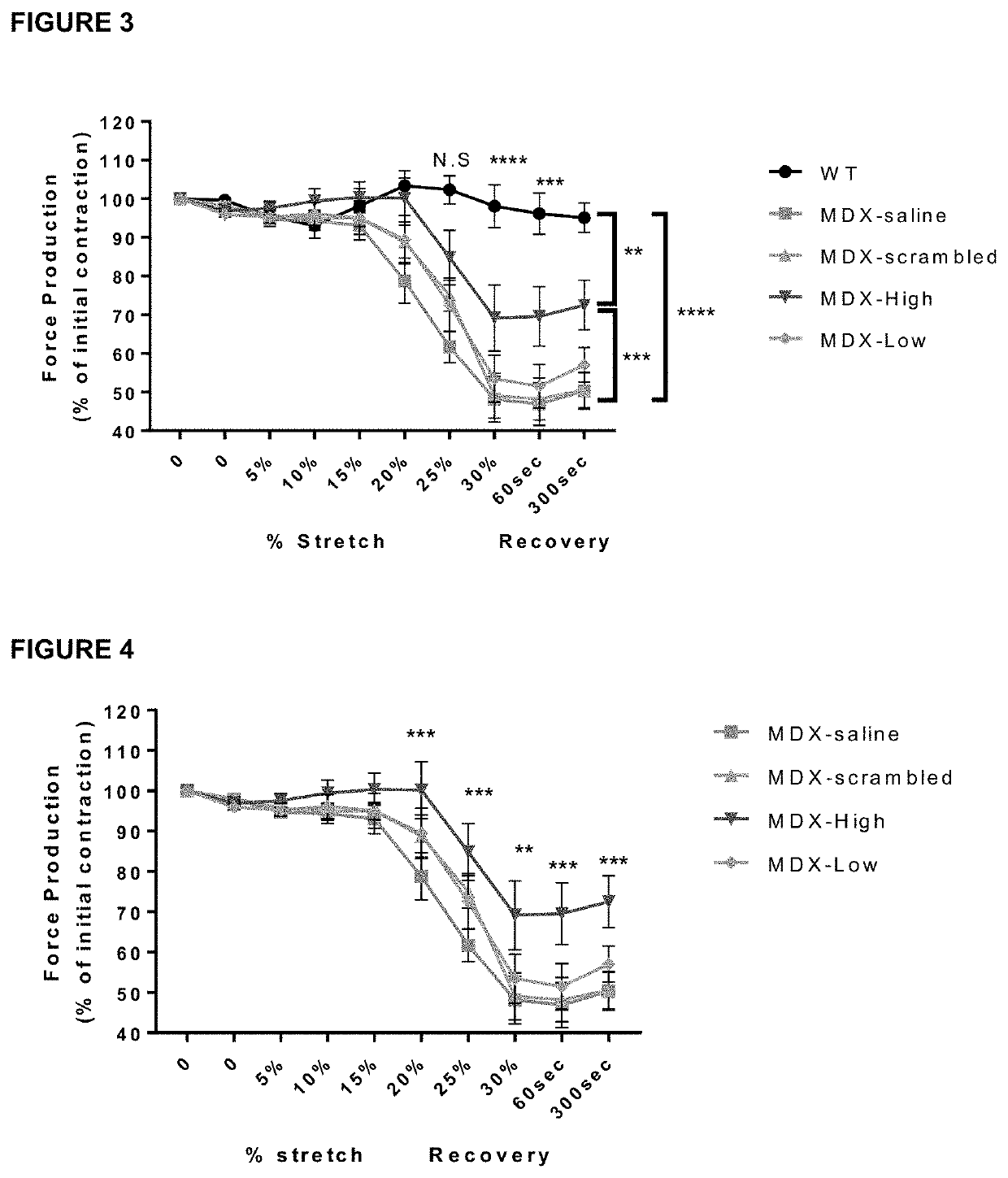Therapeutic uses and methods
a technology for muscular disorders and compositions, applied in the field of compositions and methods for treating muscular disorders, can solve the problems of further loss of function and self-care ability, impaired mobility, and loss of walking ability, and achieve the effects of reducing the progression rate of muscular dystrophy, increasing muscle strength, and increasing muscle performance or delay
- Summary
- Abstract
- Description
- Claims
- Application Information
AI Technical Summary
Benefits of technology
Problems solved by technology
Method used
Image
Examples
example 1
[0275]In one embodiment, ATL1102 is administered to non-ambulant juvenile (or pubescent) boys 10 years or older with DMD weekly at about 1.5 mg / kg (about 50 to 100 mg) and 3 mg / kg (100-200 mg) and 4.5 mg / kg (150-300 mg) for up to 12 weeks. The effects of the administered oligonucleotide for example on motor / muscle function and inflammatory markers are measured. Markers for muscle degeneration-regeneration and fibrosis are also assessed. Markers may be detected in situ or samples such as in plasma, urine, or muscle biopsy. Inspiratory and expiratory pressures, peak cough flow, FVC are assessed to evaluate change in respiratory performance. Percent change in normalized upper extremity reachable surface area, percent change in Performance of the Upper Limb Assessment score, percent change in Person-Reported Outcome Measure Upper Limb (PROM-UL) functional capacity score are used to assess muscle function. Quality of life questionnaires are useful in determining the effect of treatments....
example 2
[0277]In one embodiment, ATL1102 is administered to ambulant paediatric boys 4-11 years old with DMD weekly at about 1.5 mg / kg (about 10 to 100 mg) and 3 mg / kg (20-200 mg) and 4.5 mg / kg (30-300 mg) for up to 12 weeks. The effects of the administered oligonucleotide for example on motor / muscle function and inflammatory markers are determined. Ambulant paediatric boys may be good walkers or poor walkers. Maintenance or reducing the loss of walking capacity may be assessed by the methods known to those skilled in the art.
example 3
[0278]In one embodiment, 10 non-ambulant DMD patients 12 to 18 years of age receive ATL1102 at a starting dose of 3 mg / kg once weekly for 4 weeks. The first 5 patients continue dosing at 3 mg / kg / week for a further 4 weeks and the remaining 5 patients dose escalate to 4.5 mg / kg / week (twice weekly 2.25 mg / kg) for 4 weeks. After 8 weeks of treatment a 4 week monitoring period is performed. In the treatment and monitoring period, assessments are at baseline, 2 weeks, 4 weeks, 6 weeks, 8 weeks, and 10 and 12 weeks. The primary activity outcome is to assess the number of circulating lymphocytes, CD4+ and CD8+ T cells, and hi CD49d T cells at 4 and 8 weeks of treatment vs baseline and safety including injection sites reactions, platelet changes, liver enzyme GGT-bilirubin, CRP and albumin, A / G ratio changes. Secondary endpoints clinical assessments are measures of strength, in upper limb function, and functional capacity, quality of life, and respiratory markers and MRI assessment of muscl...
PUM
| Property | Measurement | Unit |
|---|---|---|
| limb strength | aaaaa | aaaaa |
| strength | aaaaa | aaaaa |
| pH | aaaaa | aaaaa |
Abstract
Description
Claims
Application Information
 Login to View More
Login to View More - R&D
- Intellectual Property
- Life Sciences
- Materials
- Tech Scout
- Unparalleled Data Quality
- Higher Quality Content
- 60% Fewer Hallucinations
Browse by: Latest US Patents, China's latest patents, Technical Efficacy Thesaurus, Application Domain, Technology Topic, Popular Technical Reports.
© 2025 PatSnap. All rights reserved.Legal|Privacy policy|Modern Slavery Act Transparency Statement|Sitemap|About US| Contact US: help@patsnap.com



